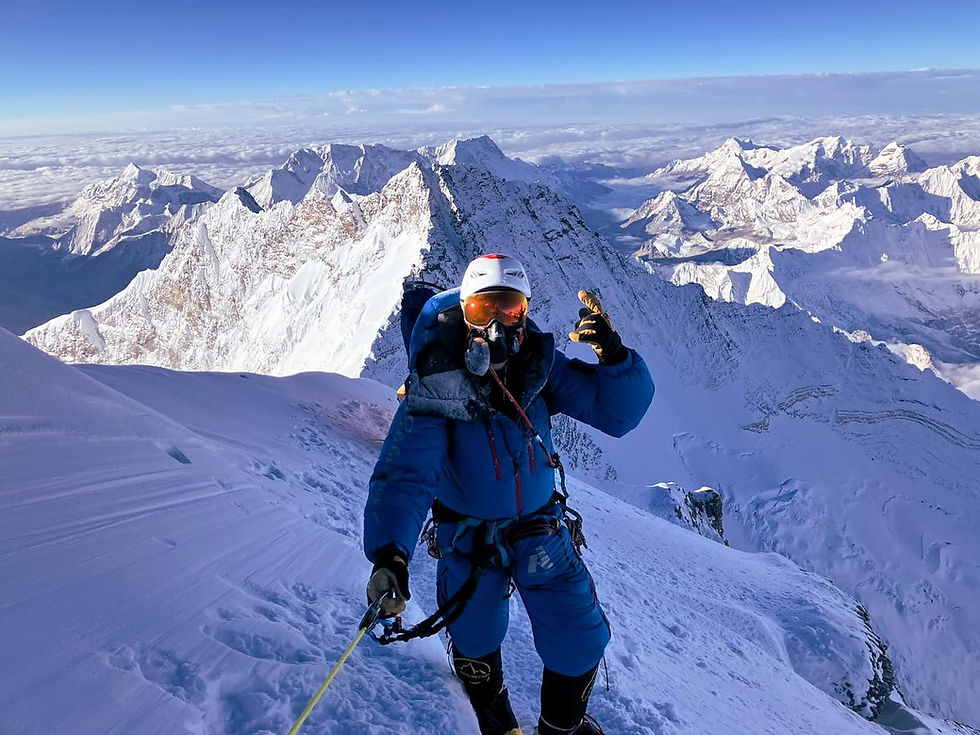My First Experience as a Guide on Everest (2024)
- Paul Guerra
- Sep 24
- 4 min read

The year 2024 marked a turning point in my career as a mountain guide. It was my very first time on Everest — a mountain wrapped in myths, dreams, fears, and doubts. I constantly asked myself whether I was truly ready to guide in such an extreme and demanding environment.
That season, my client was Thais Herrera, a woman from the Dominican Republic whom I had known for years. We had already shared expeditions to Aconcagua, Denali, Cotopaxi, Cayambe, and Chimborazo, and over time our relationship had grown into a true friendship. This time, we were heading together to the highest mountain in the world.
The Uncertainty at the Start
Our original plan was to climb via the north side, entering through Tibet. It was a special year: China was reopening Everest for the first time since the COVID-19 pandemic, which created uncertainty about the permits. With that doubt hanging over us, we traveled to Nepal to meet the rest of the expedition.
Following the advice of a great friend, Willy Benegas, we hired the services of Furtenbach Adventures, a company I hadn’t known before but soon realized was a leader in 8,000-meter expeditions, with world-class safety protocols.
In Kathmandu, everything seemed ready — or so we thought. Upon arrival, we were informed that the permits would take longer than expected. To avoid losing acclimatization, we were sent to the Langtang Valley, where we trekked and climbed 5,000-meter peaks.
When we returned, the situation was still complicated: the north-side permits were delayed, leaving us barely enough time for a summit attempt. That’s when Lukas Furtenbach, the company’s owner, proposed something unexpected: to switch us, at no extra cost, to the south-side expedition, which was already underway with an acclimatization plan on Mera Peak.
For Thais, it was the best option, but for me it meant facing the dreaded Khumbu Icefall — as magnificent as it is dangerous, and the only gateway to the south side. We decided to go for it. Thais’ dream — and mine too — was worth it.
The Strength of Thais
Thais is an incredibly strong woman. After losing her husband a few years ago, she found in the mountains a path of self-discovery. Her big goal: to complete the Seven Summits and become the first Dominican woman to stand on the summit of Everest.
Her physical preparation was excellent, but the other “Everest” had been finding the resources. In a country without a mountaineering tradition, where few people grasp the magnitude of such a project, securing funding was already a summit in itself.
The Road to Everest
Our acclimatization rotation on Mera Peak (6,500 m) went perfectly. Afterward, we flew to the South Base Camp of Everest (5,400 m), where I discovered another side of the expedition: a temporary settlement, almost a city, with unexpected comforts at that altitude — from cappuccino machines to heated domes, Western chefs, and hot showers. Everything designed so the body would suffer as little as possible.
Life at base camp was slow: walking on the glacier, training, reading, playing cards, resting, and, above all, waiting for the much-anticipated weather window. That year, the mountain gave us a miracle: five straight days of perfect conditions (May 21–25), something that hadn’t happened in a long time.
The Climb
Our company split the team into smaller groups to stagger the summit pushes. Progress through the camps went smoothly: steady pace, proper rest, flawless adaptation. We hit a setback with an unexpected storm that forced us to retreat from C3 to C2, but otherwise everything unfolded with surprising normalcy.
Summit day was indescribable. As we climbed toward the South Summit, the sunrise painted the Himalayas in golden light. I don’t usually cry in the mountains, but this time the tears came freely.
We reached the top with very few people around us, in an atmosphere of calm and safety rarely found on Everest. It was a moment of triumph, relief, and deep gratitude.
The Descent: The Real Test
But the mountain never ends at the summit. That same day, we had to descend all the way to C2. Exhaustion weighed heavily on Thais, both physically and mentally, yet she stayed strong. My responsibility was to keep her alive and safe, pushing just enough so that we wouldn’t run out of oxygen and could leave the “death zone” without risk.
In the end, we did it — exhausted, but whole.
Final Reflection
My first time as a guide on Everest was much more than an expedition: it was a journey of lessons learned, fears overcome, friendships strengthened, and dreams fulfilled.
That day, I confirmed that the summit is not only a physical place but also a state of the soul. And that, as guides, we don’t just lead people to the mountains — we lead them to their own limits and discoveries.
¿Quieres que lo deje así como relato personal estilo blog (emocional y narrativo), o prefieres que lo adapte un poco más al estilo artículo profesional para publicarlo en tu web como guía de montaña?



Comments